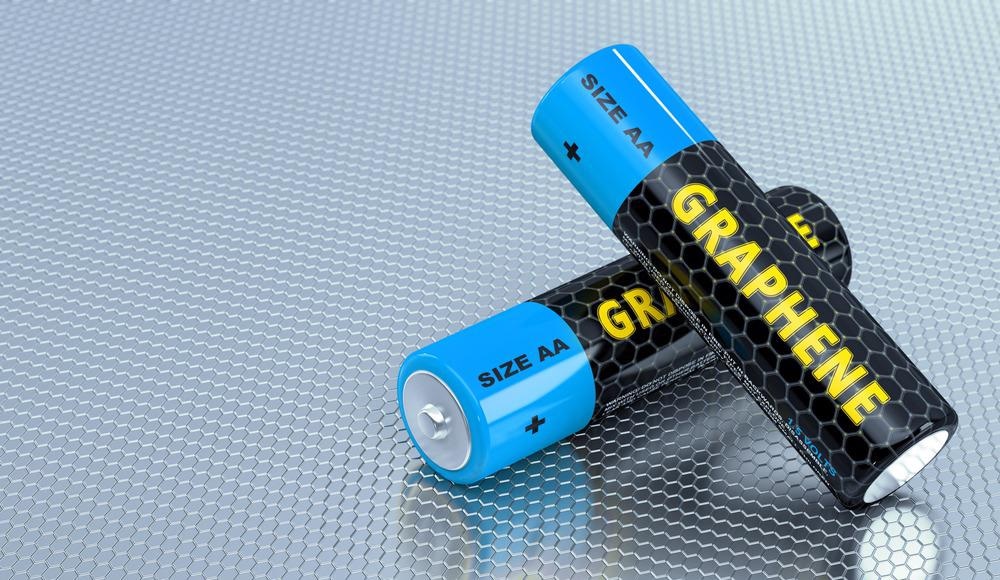Since its isolation in 2004 in its freestanding form, graphene has sparked tremendous attention and the huge range of exceptional and desirable electrochemical characteristics which has made it one of the most promising candidates for use in energy storage applications.

Image Credit: Black_Kira/Shutterstock.com
Energy storage is a significant study subject where the desire for greater energy device performance and the need for cleaner energy supplies has sparked a lot of interest. Regarding graphene's electrochemical applications in energy storage devices, from its usage as a supercapacitor to applications in batteries, graphene's significance in this technologically significant sector is illustrated.
What is Graphene, Anyway?
Graphene is a carbon allotrope with a two-dimensional hexagonal structure. By altering production techniques, it can be converted into zero-dimensional fullerenes, one-dimensional carbon nanotubes, and three-dimensional graphite. As a result, graphene serves as a foundation for additional graphite compounds.
Graphene has a variety of unique features. Its tensile strength is 130 GPa, which is 100 times that of steel. Its thermal conductivity is three times that of a diamond. It is conductive at normal temperatures and operates far faster than today's conductors. Graphene is made up of only one carbon atom. It is thought to have a large specific surface area, excellent conductivity, and a honeycomb-like structure, making it suitable for battery applications.
Graphene Battery Technology
In the same way that conventional batteries require two electrodes and an electrolyte solution to facilitate ion movement, graphene batteries do as well. Graphene-based batteries are distinguished from solid-state batteries in the composition of one or both electrodes.
Although carbon isotopes can be utilized in the anode, the cathode is where the shift happens. The cathode of a typical battery is solely formed of solid-state materials, but the cathode of a graphene battery is composed of a composite hybrid material that combines both solid-state metallic components and graphene.
For Li-ion cathodes, for example, a combination of vanadium oxide (VO2) and graphene can be employed to provide swift charge and discharge. In this scenario, VO2 has a high energy capacity but low electrical conductivity, which may be rectified by attaching VO2 to graphene as a structural "backbone," resulting in a hybrid material with both increased capacity and superior conductivity.
Possible Applications of Graphene Use in Batteries
Graphene has the potential to create next-generation energy storage systems with functionalities that are currently impossible. Because current batteries and supercapacitors are stiff, bending them might cause electrolyte leakage and cell damage. Graphene, on the other hand, maybe deformed in the direction normal to its surface without inflicting any harm because of its two-dimensional, one-atom-thick structure.
Graphene is a potential material for flexible batteries due to its enormous surface area, inherent mechanical flexibility, and exceptional electrical properties.

Image Credit: Lightboxx/Shutterstock.com
Furthermore, because graphene promotes quicker ion and electron transport in the electrodes, graphene-enabled lithium-ion batteries may be charged and discharged in a fraction of the time. For example, a lithium-ion battery atop flexible graphene foam filled with nanoscale LiFePO4 cathode and Li4Ti5O12 anode materials may be fully charged in under 18 seconds. The anode can also be made of pure graphene to increase capacity and charge/discharge rates.
Because of its high conductivity and transparency (up to 97.7% transmittance), graphene is a promising contender for improving the efficiency of transparent batteries. It might be utilized as an electrode in transparent energy storage devices, smart windows, solar cells, and other optoelectronic systems.
Current Challenges
Researchers have developed graphene-based batteries that outperform commercially available batteries in recent times. However, the technique has yet to be commercialized. There are still two key obstacles to overcome:
- A scarcity of effective mass-production technologies for high-quality graphene.
- Currently, production costs are excessively expensive.
It costs tens of thousands of dollars to produce one kilogram of graphene, depending on the material quality requirements. Because activated carbon, which is currently used in supercapacitors, is inexpensive ($15 per kilogram), competing materials are finding it difficult to get into the commercial market.
Recent Studies in Graphene Use in Batteries
Scientists have spent the last decade working to improve the overall electrochemical performance and dependability of current batteries. They've created and tested several different graphene composite-equipped batteries. Using a simple templated self-assembly approach, researchers created an optimum reduced graphene oxide/silicon composite. Graphene forms a three-dimensional network that supports silicon nanoparticles evenly.
Current lithium-ion polymer batteries have lower gravimetric and volumetric energy densities than graphene-based quasi-solid-state lithium-oxygen batteries. The system consists of a 3D porous graphene cathode, a porous graphene/Li anode, and a redox mediator-modified gel polymer electrolyte.
Conclusion
Graphene-based batteries are swiftly catching up to traditional solid-state batteries in terms of efficiency. It won't be long before graphene-based batteries beat their solid-state counterparts, thanks to ongoing breakthroughs in the field. Graphene batteries are an excellent alternative to batteries with equal efficiency, which is why researchers are working to improve this type of battery.
References
D. A. C. Brownson, D. K. Kampouris, and C. E. Banks, “An overview of graphene in energy production and storage applications,” J. Power Sources, vol. 196, no. 11, pp. 4873–4885, 2011, https://www.sciencedirect.com/science/article/pii/S0378775311003764
H. Kim, K. Y. Park, J. Hong, and K. Kang, “All-graphene-battery: Bridging the gap between supercapacitors and lithium-ion batteries,” Sci. Rep., vol. 4, pp. 1–8, 2014, https://www.nature.com/articles/srep05278
R. Privette, I. Do, H. Wang, H. Bambhania, and L. Wang, “High capacity silicon-graphene anode for Li-Ion batteries,” 31st Int. Batter. Semin. Exhib. 2014 Prim. Second. Batter. - Other Technol., pp. 183–195, 2014. https://www.nasa.gov/sites/default/files/atoms/files/1-nasa_aerospace_battery_workshop_presentation_-_privette_xg_sciences.pdf
M. F. El-Kady, Y. Shao, and R. B. Kaner, “Graphene for batteries, supercapacitors and beyond,” Nat. Rev. Mater., vol. 1, no. 7, pp. 1–14, 2016, https://www.nature.com/articles/natrevmats201633
Disclaimer: The views expressed here are those of the author expressed in their private capacity and do not necessarily represent the views of AZoM.com Limited T/A AZoNetwork the owner and operator of this website. This disclaimer forms part of the Terms and conditions of use of this website.